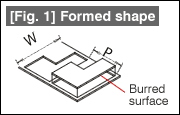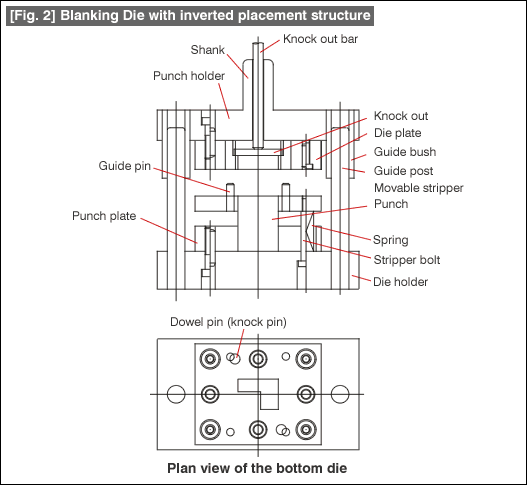#028 Basics of Die Structure (3) Structure of Blanking Dies - 3
| This is a blanking work of a special form. As is shown in Fig. 1, the formation is done by pushing from below to above. |  |
The structure of the die for this is shown in Fig. 2.

The product gets bent to some extent during blanking work. While this is due to the forces associated with the blanking operation and cannot be avoided, it is of course desirable that a flat product is obtained. This inverted placement structure was conceived as a countermeasure against the product getting bent.
The feature of the inverted placement structure is that the punch is placed as the bottom die and the die is placed as the top die. The blanked product enters the die. It will be necessary to discharge the product that has entered the die. The part for doing this is called the knock out. The knock out is linked to the pressing machine via the knock out bar.
The relationship between the blanking work and the knock out operation is as follows. The material is blanked near the bottom dead point of the pressing machine, and the product goes into the die. The die rises as it is, and near the top dead point of the pressing machine, the knock out bar of the die gets hit by the knock out part (called the knock out bar) of the pressing machine, the linked knock out gets pressed, and the product is discharged (ejected) from the die. A very common method of pushing away the discharged product is to blow it off using compressed air.
Using this type of structure for preparing flat products is because it is possible to reduce or suppress the bending that is caused during the blanking operation because the material is pressed down by the knock out. In the structure shown in Fig. 2, since the knock out has only penetrated into the die, the effect is small as a countermeasure against bending. In order to get much stronger effect, a spring is placed behind the knock out so that the knock out strongly presses against the material. In this case, since the product inside the die is pushed out due to the force of the spring, it is does not matter even if there is no knock out bar in the die. The product will be pushed back into the scrap. The product is then recovered by removing it from the scrap.
The method of moving the product that has once been blanked after pushing it back into the material in this manner is called a "push back method".
Since in the form of installing a spring behind the knock out inside the die, the material is pushed from a direction opposite to the direction of movement of the punch, this form is called the material reverse pressing (or simply reverse pressing). Reverse pressing is not for only the inverted placement structure, but even in a structure in which the punch is above and the die is below (this structure is called the upright placement structure), the pressing member that presses in a direction opposite to the direction of movement of the punch is called a reverse pressing member.
- #167 Problems in Punching and their Countermeasures (6) Scrap Processing in Punching
- #166 Problems in Punching and their Countermeasures (5) Trimming of Drawn and Shaped Parts
- #165 Problems in Punching and their Countermeasures (4) Scrap Clogging in Punching
- #164 Problems in Punching and their Countermeasures (3) Bending and Twisting of Narrow Punched Parts
- #163 Problems in Punching and their Countermeasures (2) Bending due to Punching



